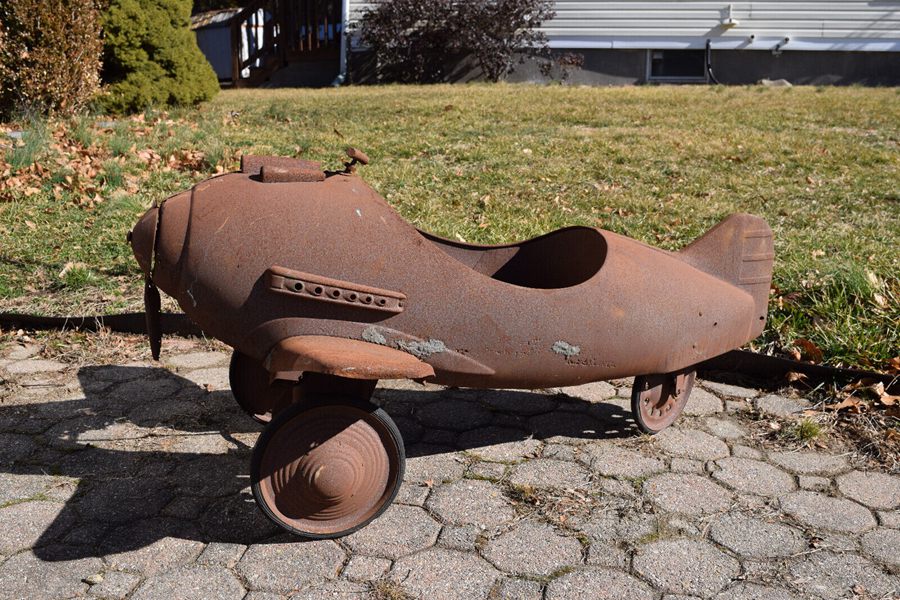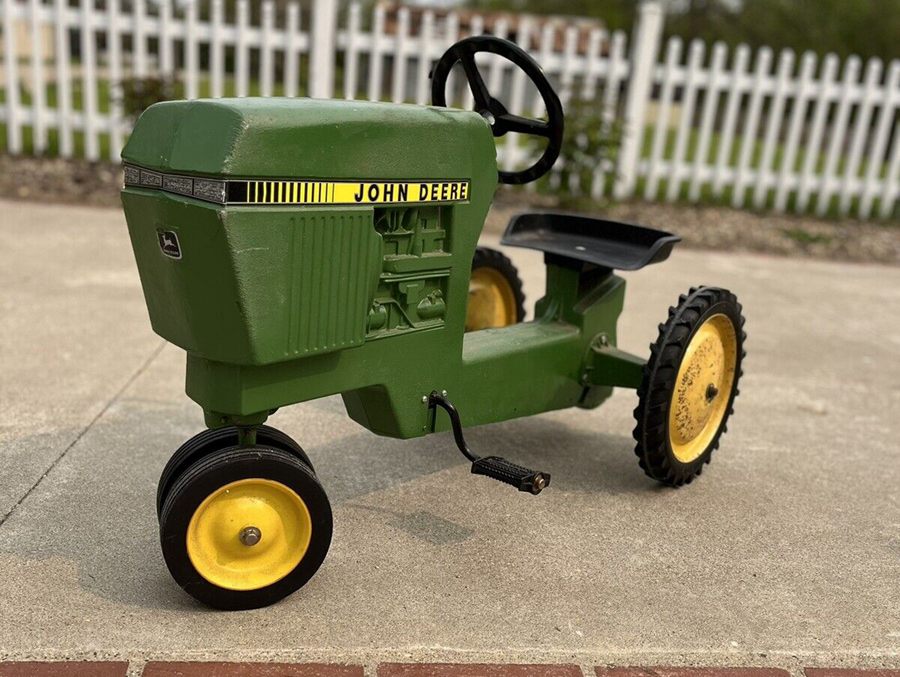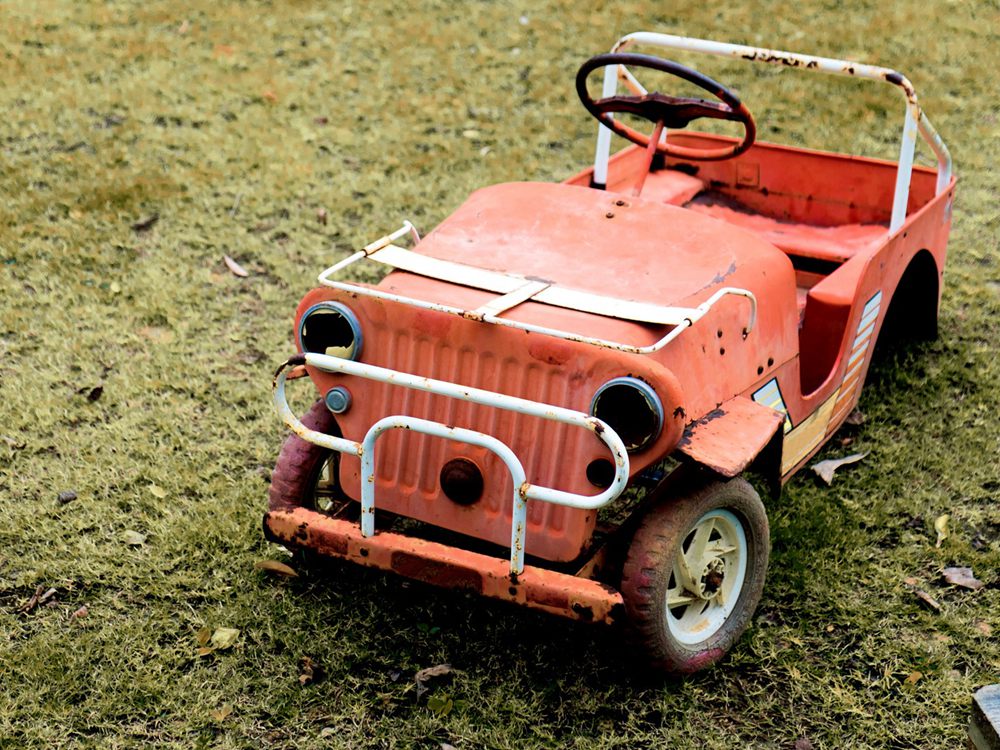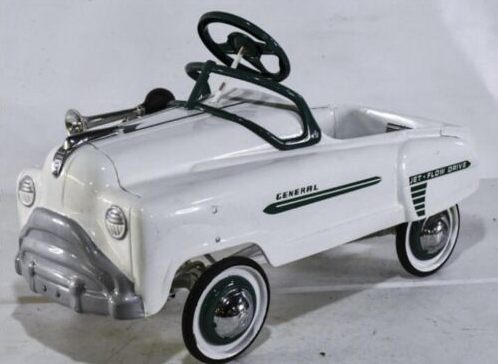Antique toy pedal cars have been a cherished part of childhood for over a century. As a collector or vintage enthusiast, you should know that these timeless treasures are not only known for their nostalgic value but also their increasing monetary worth. With a rich history dating back to the early 1900s, pedal cars have evolved in design and materials, making them much sought-after collectibles today.
During the pre-war era, pedal cars played a significant role in the evolution of transportation-themed toys. Several manufacturers, such as Garton, produced metal-bodied pedal cars that mimicked popular automobile designs of the time. Innovations in manufacturing and materials led to a wide variety of pedal car styles, including the well-known Sad Face, Three-wheeled, and Tot Rod models. Each of these pedal cars is unique in its own way, with the Sad Face being the most valuable among collectors.
To identify and determine the value of an antique toy pedal car, it’s essential to consider factors such as the date and age, materials used, and paint finishes. Additionally, understanding the historical context of these pedal cars will give you a better appreciation for their worth and significance in the world of vintage collectibles. Armed with this knowledge, you’re well on your way to discovering the fascinating world of antique toy pedal cars.
Table of Contents
The History & Evolution of Antique Toy Pedal Cars
In the early 20th century, toy pedal cars rose to popularity as a favorite pastime for children. They were designed to resemble real automobiles, allowing kids to experience the thrill of driving. As an antique toy collector or enthusiast, you may find the history and evolution of these cars fascinating.
The first toy pedal cars appeared around 1900, mainly in the United States. Skilled craftsmen and companies used wood, steel, and sheet metal to create these mini cars, which closely imitated models produced by popular automakers like Ford and Chevrolet. Early examples of toy pedal cars often had simple, handmade designs and basic features such as foot pedals, a steering wheel, and a seat.
In the 1920s and 1930s, advancements in manufacturing and technology led to a boom in the production of antique toy pedal cars. Companies like American National, Gendron, and Murray took the lead in manufacturing these cars, introducing new materials, more intricate designs, as well as rubber tires and functioning lights. Some popular models from this era include the American National Scout Roadster and the Gendron Pioneer Racer.
Moving into the post-World War II era, toy pedal cars saw even more prolific development due to the economic boom. The 1950s saw the emergence of the now-iconic pedal car styles including the Murray Fire Truck, AMF Mustang, and the Murray Sad Face Police Car. Toys producers began to focus on creating more realistic details, such as chrome trim, decals, and logos.
How to Tell if a Toy Pedal Car is Antique or Old
When trying to determine if a toy pedal car is antique or old, there are several factors to consider. These factors can help you identify the type and value of your pedal car.
Check the Brand and Model
One of the primary ways to determine if your pedal car is antique or old is by identifying its brand and model. Manufacturers like Garton Toy Company, Murray, and AMF produced popular pedal cars, such as the Lincoln Zephyr, Kidillac, or Hot Rod models. By looking for branding or logos on the pedal car, you can find out more about its origin.
Examine the Wheels and Construction
Another factor to consider when trying to determine the age of a pedal car is its construction, particularly the wheels. Murray wheels, for example, typically have 6 tabs, while AMF wheels usually have 3 slots. This difference in construction can help you identify if the pedal car is antique or old. Additionally, look for details in the craftsmanship, such as metal or wooden materials, to help determine the age of the toy.
Inspect the Details and Features
Some antique or vintage pedal cars have specific features that distinguish them from newer models. For example, the Electric Rolls from the U.K.’s Lines Bros had working brakes, headlights, and real Dunlop tires. Pay attention to the various features and accessories on your pedal car, as this can provide clues to its age.
Consult Toy Pedal Car Collectors and Specialists
Finally, if you’re still unsure about the age of your toy pedal car, consult collectors or specialists who are knowledgeable in the field. They may be able to provide insight into the types of antique toy pedal cars, as well as to help identify and value your pedal car.
Remember that the value of an antique toy pedal car largely depends on its age, rarity, and condition, so identifying these factors is essential to understanding its worth. Taking the time to inspect your pedal car thoroughly can lead to an accurate assessment of its historical and monetary value.
Antique Toy Pedal Car Manufacturers
When exploring the world of antique toy pedal cars, it is important to become familiar with the key manufacturers that produced these collectibles throughout history. Some of the most notable toy pedal car manufacturers include:
- Garton Toy Company: Established in 1879 in Sheboygan, Wisconsin, Garton Toy Company was a leading pedal car manufacturer known for their high-quality products and innovative designs. In 1961, they introduced the Casey Jones Pedal Locomotive, paying tribute to the railroad industry and a legendary rail man.
- Murray Ohio Manufacturing Company: Founded in 1919 in Cleveland, Ohio, Murray Ohio Manufacturing Company initially produced bicycle parts but expanded into the pedal car market during the 1920s. They built various pedal car models, including hot rods, convertibles, and tricycles, which were popular among children at the time.
- American National Company: Also known as Gendron, this Toledo-based manufacturer started producing pedal cars in 1900. They were known for creating a diverse range of models, including fire engines, trucks, and even airplanes.
- Steelcraft: Founded in 1920, Steelcraft was a prominent player in the pedal car market. Their notable models include the Steelcraft Chrysler Airflow, which was produced in the 1930s and featured a unique streamlined design.
To identify and value antique toy pedal cars, consider the following factors:
- The manufacturer: Collectors often have preferences for certain manufacturers, and some brands may be rarer or more desirable than others.
- Condition: The overall state of the pedal car is crucial in determining its value. Cars in their original condition, with minimal wear and intact paintwork, are generally more valuable.
- Rarity: The rarity of the specific make and model can significantly impact the car’s value. Limited edition models, like the Garton Casey Jones Pedal Locomotive, would typically be worth more.
- Age: Older pedal cars, particularly those from the early 1900s, are likely to be more valuable than their newer counterparts.
Remember to consult price guides, collector forums, and auction sites to gain a better understanding of the antique toy pedal car market and to stay informed about the latest trends and values.
Types of Antique Toy Pedal Car and Their Values
When it comes to antique toy pedal cars, there are several types available with varying values. Each type has its unique characteristics, features, and mechanisms that set it apart from other toy pedal cars. Here are three main types that you should be familiar with:
1. Old Sad Face Pedal Cars
These pedal cars resemble miniature fire vans, featuring exposed motors, ladders, and v-bonnets. The name “Sad Face” comes from their front design, which has a sad facial expression. Their value will depend on factors such as rarity, condition, and manufacturer.
2. Airplane Pedal Cars

These unique pedal cars are designed to look like World War I airplanes, often featuring German markings, original green paint, fold-up tailplanes, and drop-in wings. Given their historical significance and unique design, these airplane pedal cars can be valuable to collectors.
3. Pedal Car Tractors

Designed like miniature tractors, these pedal cars were particularly popular among children during the early 20th century. Brands such as John Deere produced pedal car tractors making them quite collectible. The value of these toy tractors will vary based on factors such as brand, condition, and age.
5 Factors to Identify & Value Antique Toy Pedal Cars
1. Ages
When discussing antique toy pedal cars, it’s essential to understand the different ages and eras of these collectible items. This section will provide you with a brief overview of the various ages, which will help you in identifying and valuing your pedal car.
In the late 1800s, pedal cars for children first appeared with the invention of Karl Benz’s three-wheel Patent Motorwagen for adults. By the early 1900s, pedal cars were popular in the United States, England, France, and Australia. Over the years, these pedal cars have evolved, with various manufacturers producing unique designs and styles that catered to consumer preferences of the time.
Below are the key factors that affect the value of an antique toy pedal car:
- Age
- Manufacturer
- Rarity
- Condition
A valuation table for each factor will help you determine the average value of your antique pedal car.
Age Valuation
| Age | Average Valuation |
|---|---|
| Late 1800s – 1910 | $800 – $1,200 |
| 1910s – 1920s | $1,000 – $1,300 |
| 1930s | $700 – $1,000 |
| 1940s | $600 – $1,000 |
| 1950s – 1960s | $300 – $700 |
2. Brands
When examining antique toy pedal cars, it’s essential to be familiar with some of the well-known manufacturers and brands that produced these timeless collectibles. These brands often have specific models and styles that are highly sought after by collectors, which can significantly impact their value.
Here are some of the notable antique toy pedal car brands:
- American National
- Steelcraft Wheel Goods
- Gendron Iron Wheel Co.
- Garton Toy Company
- Cyclops
- Austin J40
- Eureka Toledo Wheel
- Butler Bros.
- Murray Pedal Cars
Manufacturer Valuation
| Manufacturer | Average Valuation |
|---|---|
| American National | $700 – $1,200 |
| Garton Toy Company | $600 – $1,000 |
| Murray-Ohio | $500 – $800 |
| AMF | $300 – $600 |
| Marx | $250 – $500 |
3. Materials
Antique toy pedal cars were made from a wide range of materials as manufacturing methods evolved over time. The choice of materials impacted the cars’ durability, aesthetics, and value.
In the early years of pedal car production, wood was the most prevalent material. Makers crafted these early toy vehicles using sturdy wooden bodies and metal frames. Although wooden pedal cars are less common today, they still hold a high level of nostalgia and collectibility.
By the 1930s, manufacturers began using sheet metal, predominantly steel, for pedal car bodies. This transition allowed for increased production efficiency and introduced new designs that mirrored the sleek automotive styles of the era. Pressed steel pedal cars continue to be among the most sought-after and valuable.
Post-War pedal cars in the 1950s saw the introduction of aluminum and fiberglass bodies. These materials allowed for lightweight designs and more intricate details that closely resembled full-sized cars. Although not as timeless as wooden and pressed steel versions, some collectors appreciate post-War pedal cars for their unique mid-century designs.
A key aspect to consider when determining the value of an antique toy pedal car is the original material used, with rarity often impacting the overall valuation. Below is an estimation of average values based on the material composition:
| Material | Average Valuation |
|---|---|
| Wood | $400 – $600 |
| Pressed Steel | $600 – $1000 |
| Aluminum | $300 – $500 |
| Fiberglass | $250 – $450 |
4. Condition
When evaluating the value of antique toy pedal cars, assessing their condition is crucial. The condition determines how much a collector would be willing to pay for a particular piece. Generally, the better the condition, the higher the value. In this section, we will discuss the factors that affect the value of antique toy pedal cars.
- Originality: A pedal car that has its original paint, decals, and accessories will generally be more valuable than one that has been restored or altered. If possible, try to keep all the original parts with the pedal car to maintain its value.
- Rust and Dents: Check for rust and dents on the body of the pedal car, as these can decrease its value. Surface rust can be removed and treated, but deep rust and dents can be more challenging to fix.
- Functionality: Ensure that the pedal mechanism, steering, and wheels are functional. A pedal car that works smoothly will fetch a higher price than one that requires extensive repairs.
Now let’s take a look at a valuation table which showcases the average price for each of the key factors mentioned above.
| Condition Factors | Average Valuation |
|---|---|
| Originality: | |
| – Original Paint | $500 – $600 |
| – Restored/Altered | $300 – $400 |
| Rust and Dents: | |
| – Light Surface Rust | $400 – $500 |
| – Deep Rust & Dents | $200 – $300 |
| Functionality: | |
| – Working Pedal Mechanism | $450 – $550 |
| – Non-Functional Mechanism | $250 – $350 |
5. Design
Antique toy pedal cars come in various designs and styles, which reflect the automotive trends of their time. When examining these pedal cars, you can observe some common design elements that make them unique and collectible.
Identification Factors
To identify an antique toy pedal car, consider the following factors:
- Shape and styling (such as unique bonnets or emblems)
- Manufacturer (e.g., Garton Toy Co., Murray, Steelcraft, etc.)
- Materials used (such as cast iron or pressed steel)
- Age and condition of the pedal car (including original paint and parts)
Valuation
The value of an antique toy pedal car largely depends on its rarity, design, condition, and age. Below is a valuation table that provides a general idea of the average price range for various design factors:
| Design Factor | Average Valuation |
|---|---|
| Rare Sad Face Cars | $600 – 800 |
| Classic Pedal Cars | $400 – 600 |
| Specialty Pedal Cars | $500 – 700 |
| Cast-Iron Pedal Cars | $800 – 1,000 |
| Pressed Steel Pedal Cars | $300 – 500 |
| Restored or Excellent Condition | $700 – 1,000 |
| Original Paint and Parts | $500 – 800 |
Final Thoughts
As you continue your journey into the fascinating world of antique toy pedal cars, remember to keep the key aspects in mind when identifying and valuing these cherished collectibles. Focus on the various types of pedal cars, such as Sad Face, Three-Wheeled, and Tot Rod, each with its unique characteristics and appeal.
When trying to identify a genuine antique pedal car, pay attention to the details. Make note of the materials used, paint finishes, and any distinguishing features. This will help you distinguish between authentic pieces and replicas, ensuring you invest wisely in these precious collectibles.
While examining antique pedal cars, familiarize yourself with popular models, such as the Gendron Packard Pedal Car, and companies like Garton Toy Co. By doing so, you’ll gain a better understanding of the history and evolution of these marvelous toys, increasing your level of expertise in this niche of antique collecting.
Always cross-check values against reputable price guides and conduct thorough research while assessing the true worth of your antique toy pedal cars. Keep in mind that condition, rarity, and desirability play a significant role in determining the value of these collectibles. Therefore, ensure you factor these variables into any valuation process.
Remember, the world of antique toy pedal cars is an exciting and ever-changing landscape. Through continuous learning and exploration, you can become a knowledgeable enthusiast and informed collector, appreciating the enduring charm of these exquisite vintage toys.
FAQ
What are the main types of antique toy pedal cars?
There are several types of antique toy pedal cars, including cast iron, pressed steel, and metal-based cars. Cast iron was used in older versions due to its affordability and ease of shaping. Pressed steel cars became popular later, giving the toys more intricate details and better durability. Additionally, some antique pedal cars were made with metal-based materials, like aluminum or tin.
How can I identify my antique toy pedal car?
To identify your antique toy pedal car, consider the following factors:
- Materials used (cast iron, pressed steel, metal-based)
- Wheels (Murray wheels usually have 6 tabs, while AMF wheels have 3 slots)
- Hubcaps (presence or absence)
- Manufacturer’s logo or markings
Keep in mind hubcaps may be missing, so focusing on other identification factors may be more effective.
What factors can affect the value of my antique toy pedal car?
The value of an antique toy pedal car can be influenced by several factors:
- Age and date of manufacture
- Rarity and desirability (limited editions, unique designs)
- Brand or manufacturer
- Condition (including original paint, decals, upholstery, and mechanical parts)
- Presence of original packaging or documentation, like catalogs or manuals
- Modifications or restorations made
- Recent selling prices of similar pedal cars in the market
Keep track of these factors when assessing the value of your antique pedal car for an accurate resale price.
Where can I find price guides or identification resources for antique toy pedal cars?
Several resources are available for identifying and valuing your antique toy pedal car, including:
- Online forums and discussion groups where collectors share information
- Price guides and identification books, like the “Antique Toy Pedal Cars Identification & Value Guide” or resources from PedalCar.com
- Auction sites that list completed sales of antique toy pedal cars for reference
Remember to use multiple sources to get a broader understanding of your pedal car’s value and accurate identification.










